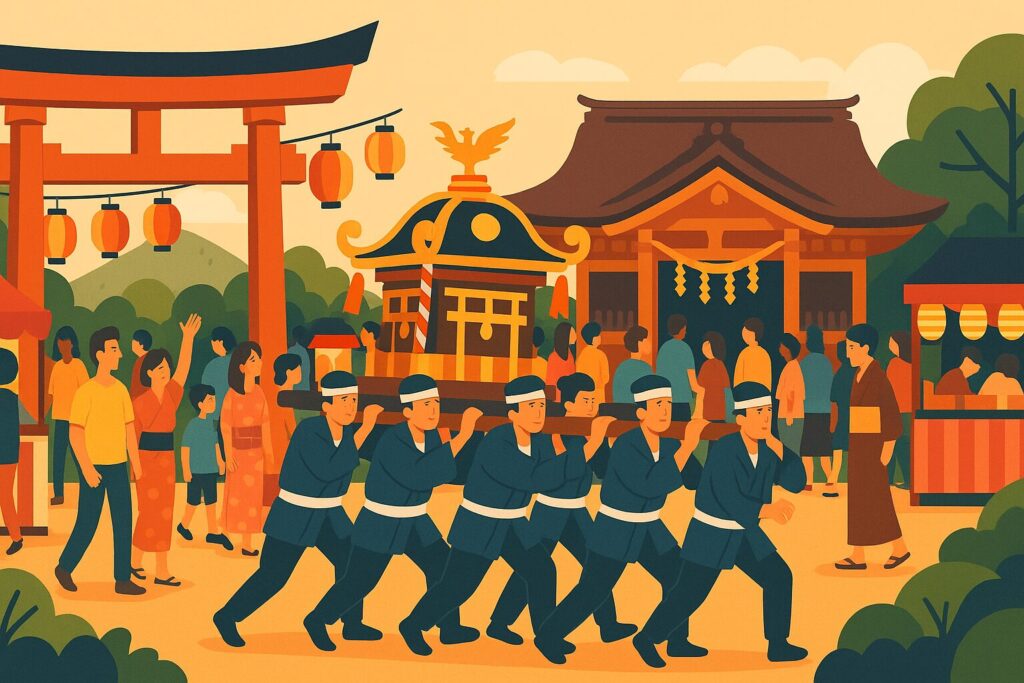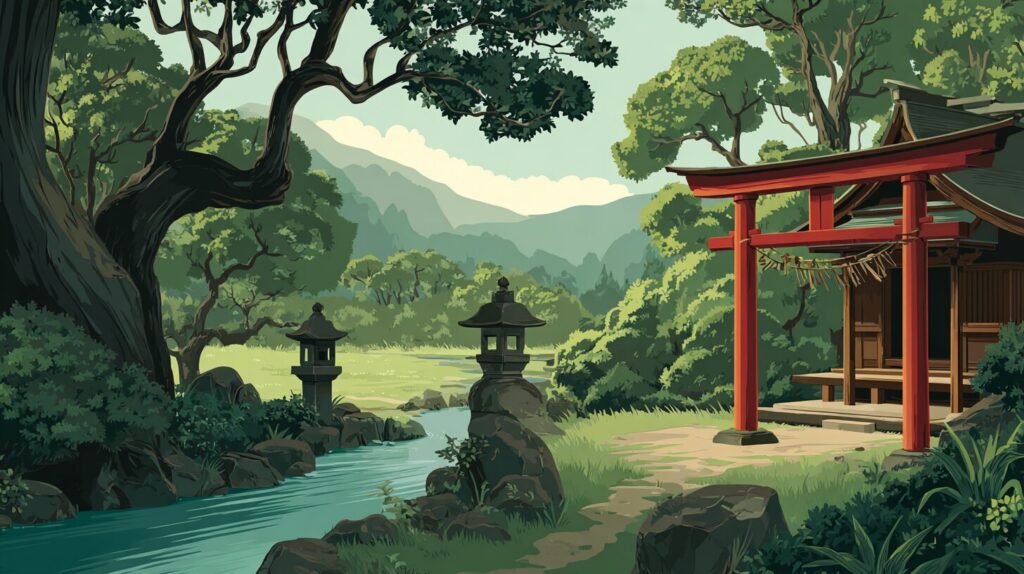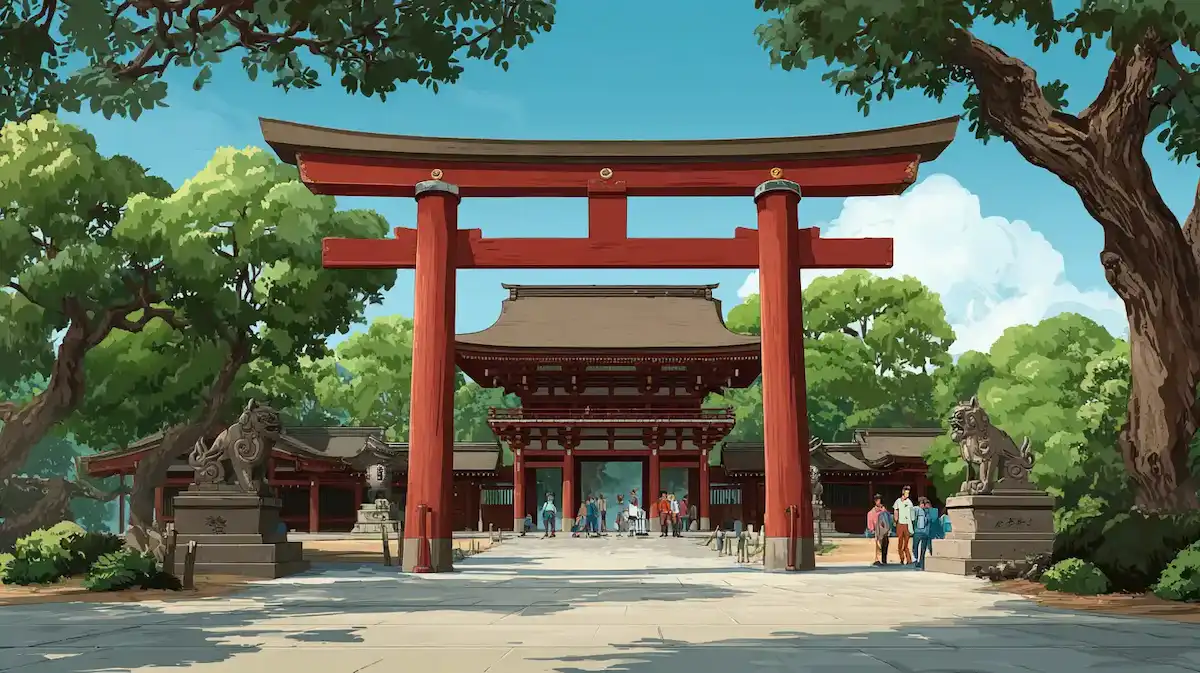神道を英語で説明・紹介するための基本情報と、英会話に役立つ表現をシンプルでわかりやすい英語で紹介します。
英会話ダイアローグ・概要・10の質問を通して、神道に関する英語表現を学びます。
英語
英会話ダイアローグを読む前に知っておくと良い前提知識と情報です。
- 神道とは
- 日本発祥の伝統的な宗教
- 「神」と呼ばれる神々や自然、祖先を信仰
- 教祖や聖典がなく、儀式や習慣を大切にする
- 神社とその特徴
- 神道の祭祀施設を「神社」と呼ぶ
- 入口には「鳥居」があり、参道や本殿がある
- 全国に8万以上の神社があるといわれている
- お参りの作法
- 鳥居で一礼、手水舎で手と口を清める
- 本殿では「二礼二拍手一礼」(2回おじぎ、2回手を打つ、1回おじぎ)が基本
- 神道と仏教の違い
- 神道は日本固有で多神教、自然崇拝が特徴
- 仏教はインド発祥で、仏像があり、手を合わせて静かに祈る
- 神道の現代的な役割
2人が神道について話しています。
神道の概要や特徴、神社での参拝方法、仏教との違い、日常生活への浸透などを話題にしています。
会話 / dialogue

Hey Key, I’ve been really curious about Shinto lately. I see so many shrines in Tokyo, but I don’t actually know much about what they mean.

That’s a great question, Mack! Shinto is Japan’s traditional religion. It’s different from Buddhism or Christianity because it doesn’t have a founder or a holy book.

So, what do people actually believe in Shinto?

Shinto is all about worshipping “kami,” which means spirits or gods. Kami can be found in nature—like mountains, rivers, trees—or even in ancestors.

I think that’s beautiful. It sounds very open-minded.

It is! In fact, there’s a saying “yaoyorozu no kami,” which means “eight million gods.” It shows how Shinto welcomes many different spirits and ideas.

What about shrines? Are they the main places for Shinto?

Exactly. Shrines are special places where people go to worship kami. You can find shrines almost everywhere in Japan, from big cities to the countryside.

I’ve visited shrines during New Year’s and festivals, but I’m not sure if I’m following the right customs. How should I pray at a shrine?

It’s actually quite simple. First, bow at the torii gate before you enter. Then, at the purification fountain, wash your hands and rinse your mouth.

And what do you do at the main hall?

You throw a coin into the offering box, bow twice, clap your hands twice, make your wish, and then bow once more. If there’s a bell, you ring it first.

That’s different from temples, right? I remember you don’t clap your hands at Buddhist temples.

Yes, that’s one of the main differences. Temples are for Buddhism, and people pray quietly with their hands together—no clapping. Shrines are for Shinto, where clapping is part of the custom.

Is there a special feeling you get when you visit a shrine?

Definitely. Shrines are peaceful and surrounded by nature. Many people feel relaxed and calm there, even if they aren’t religious.

I’ve always noticed how clean and quiet shrines are. It makes me want to slow down and appreciate the environment.

That’s part of Shinto’s appeal. It teaches respect for nature and harmony with everything around us.

And shrines are involved in a lot of life events, right? Like New Year’s, weddings, even children’s celebrations.

Yes, exactly. Many important events are connected to shrines, even for people who don’t see themselves as religious.

Are there any famous shrines you recommend visiting in Tokyo?

Meiji Jingu is the most famous. It’s huge and surrounded by a beautiful forest. But there are also many small, local shrines that have their own charm.

I’ve heard of Ise Jingu too. Isn’t that one of the most important shrines in Japan?

Yes, Ise Jingu is considered the spiritual home of Shinto, but it’s in Mie Prefecture. If you ever get the chance, it’s worth a visit.

What’s so special about Shinto compared to other religions?

Shinto is unique because it’s not strict about beliefs. It focuses on traditions, respect for nature, and community. Plus, it coexists peacefully with other religions, especially Buddhism.

That’s really open-minded. So, it’s not just about religion, but also about daily life and Japanese culture.

Exactly. For most Japanese people, Shinto is just a natural part of their lives, woven into festivals, customs, and even the way we treat nature.

I’m glad we talked about this. Next time I visit a shrine, I’ll try to follow the customs properly and pay more attention to the atmosphere.

Let’s go together sometime! I can show you some of my favorite local shrines.

That sounds perfect. Thanks, Key. I feel like I understand Shinto a lot better now.

You’re welcome, Mack. Exploring shrines is always a good way to connect with Japanese culture!
概要 / Overview
「神道」について、理解を深めるための「英語での概要」です。
神道

What is Shinto?
Shinto is the traditional religion of Japan. It began a long time ago and is a big part of Japanese culture. Shinto has no founder and no holy book. Instead, people follow old traditions, customs, and rituals that have been passed down for many generations.
The Belief in Kami
In Shinto, people believe in many gods and spirits called “kami.” Kami are everywhere in nature. They can live in trees, mountains, rivers, rocks, and even in people’s ancestors. The idea of “eight million gods” means there are countless kami in the world. Shinto teaches that nature is very important and should be respected.
Shrines and Worship
Shinto shrines are special places where people go to pray to the kami. There are many shrines across Japan, both big and small. When visiting a shrine, people follow certain steps: bow at the torii gate, wash their hands and mouth at the water basin, and then offer a prayer at the main hall. The typical way to pray is to bow twice, clap twice, pray, and bow once again.
Shinto in Daily Life
Shinto is part of many Japanese traditions and events. People visit shrines for New Year’s, weddings, and festivals. Even people who do not think of themselves as religious often take part in Shinto customs. Shinto is not just a religion—it is also a way of living in harmony with nature and the community.
10の質問 / 10 questions
「神道」について、理解を深めるための「英語での10の質問」です。
1: What is Shinto?
Shinto is the traditional religion of Japan. It focuses on worshipping spirits called kami, which are found in nature and ancestors.
2: What are kami?
Kami are spirits or gods in Shinto. People believe they live in mountains, rivers, trees, rocks, and even in ancestors.
3: Where do people go to worship in Shinto?
People go to shrines to worship kami. Shrines are special places found all over Japan.
4: How do people pray at a Shinto shrine?
People bow at the torii gate, wash their hands and mouth, offer a coin, bow twice, clap twice, pray, and bow once more.
5: Does Shinto have a holy book or founder?
No, Shinto does not have a holy book or a founder. It is based on old traditions and customs.
6: What are some important events related to Shinto?
People visit shrines for New Year’s, weddings, children’s celebrations, and local festivals.
7: What is a torii gate?
A torii gate is a traditional gate at the entrance of a shrine. It marks the boundary between the normal world and the sacred space.
8: How is Shinto different from Buddhism?
Shinto is about worshipping kami and respecting nature. Buddhism comes from India and focuses on Buddha’s teachings and enlightenment.
9: Why is nature important in Shinto?
In Shinto, people believe that kami live in nature. That is why people respect and care for nature.
10: Do people need to be religious to visit a shrine?
No, anyone can visit a shrine. Many people visit shrines for tradition or to enjoy the peaceful atmosphere, even if they are not religious.

和訳付
会話 / dialogue

Hey Key, I’ve been really curious about Shinto lately. I see so many shrines in Tokyo, but I don’t actually know much about what they mean.
ねえキー、最近神道についてすごく興味が出てきたんだ。東京には神社がたくさんあるけど、実はあまり意味を知らなくてさ。

That’s a great question, Mack! Shinto is Japan’s traditional religion. It’s different from Buddhism or Christianity because it doesn’t have a founder or a holy book.
いい質問だね、マック!神道は日本の伝統的な宗教なんだよ。仏教やキリスト教と違って、開祖や聖書みたいなものはないんだ。

So, what do people actually believe in Shinto?
じゃあ、神道って具体的に何を信じてるの?

Shinto is all about worshipping “kami,” which means spirits or gods. Kami can be found in nature—like mountains, rivers, trees—or even in ancestors.
神道は「神」をお祀りする宗教なんだ。神っていうのは、山や川、木とかの自然にもいるし、ご先祖さまも神になることがあるんだよ。

I think that’s beautiful. It sounds very open-minded.
それ、素敵だね。すごく寛容な考え方に聞こえるよ。

It is! In fact, there’s a saying “yaoyorozu no kami,” which means “eight million gods.” It shows how Shinto welcomes many different spirits and ideas.
本当にそうなんだ。実は「八百万の神」っていう言葉があって、いろんな神様や考え方を受け入れるって意味なんだよ。

What about shrines? Are they the main places for Shinto?
神社ってどうなの?やっぱり神道の中心的な場所なの?

Exactly. Shrines are special places where people go to worship kami. You can find shrines almost everywhere in Japan, from big cities to the countryside.
その通り!神社は神様をお祀りする特別な場所なんだ。日本全国どこに行っても、都会にも田舎にも神社があるよ。

I’ve visited shrines during New Year’s and festivals, but I’m not sure if I’m following the right customs. How should I pray at a shrine?
正月とかお祭りで神社に行ったことはあるけど、正しい作法が分からないんだ。どうやってお参りしたらいいの?

It’s actually quite simple. First, bow at the torii gate before you enter. Then, at the purification fountain, wash your hands and rinse your mouth.
意外と簡単だよ。まず鳥居の前で一礼して、手水舎で手と口を清めるんだ。

And what do you do at the main hall?
本殿では何をすればいいの?

You throw a coin into the offering box, bow twice, clap your hands twice, make your wish, and then bow once more. If there’s a bell, you ring it first.
賽銭箱にお賽銭を入れて、深く2回おじぎ、2回手を打って、お願いごとをして、最後にもう1回おじぎだよ。鈴があったら最初に鳴らすんだ。

That’s different from temples, right? I remember you don’t clap your hands at Buddhist temples.
それってお寺とは違うよね?仏教のお寺では手を叩かないって聞いたことがある。

Yes, that’s one of the main differences. Temples are for Buddhism, and people pray quietly with their hands together—no clapping. Shrines are for Shinto, where clapping is part of the custom.
うん、それが大きな違いの一つだよ。お寺は仏教の場所だから、静かに手を合わせて祈るだけ。拍手はしないんだ。神社は神道だから、拍手を打つのが特徴だね。

Is there a special feeling you get when you visit a shrine?
神社に行くと、何か特別な感じがするの?

Definitely. Shrines are peaceful and surrounded by nature. Many people feel relaxed and calm there, even if they aren’t religious.
うん、神社はとても静かで自然に囲まれていることが多いから、信仰心がなくてもリラックスできるし、落ち着くって人が多いよ。

I’ve always noticed how clean and quiet shrines are. It makes me want to slow down and appreciate the environment.
僕も神社がすごくきれいで静かなのがいつも印象的だなって思ってた。ゆっくり環境を感じたくなるよね。

That’s part of Shinto’s appeal. It teaches respect for nature and harmony with everything around us.
それが神道の魅力の一つなんだ。自然を大切にしたり、周りと調和することを教えてくれる宗教だからね。

And shrines are involved in a lot of life events, right? Like New Year’s, weddings, even children’s celebrations.
それに神社って、いろんな人生のイベントでも使われるよね?お正月とか、結婚式とか、子供のお祝いも。

Yes, exactly. Many important events are connected to shrines, even for people who don’t see themselves as religious.
そうそう。自分では宗教心がないと思ってる人でも、大事な行事には自然と神社に関わることが多いんだ。

Are there any famous shrines you recommend visiting in Tokyo?
東京でおすすめの有名な神社ってある?

Meiji Jingu is the most famous. It’s huge and surrounded by a beautiful forest. But there are also many small, local shrines that have their own charm.
一番有名なのは明治神宮かな。とても大きくて、森に囲まれてるんだ。でも、小さな地元の神社にもそれぞれ雰囲気があって良いよ。

I’ve heard of Ise Jingu too. Isn’t that one of the most important shrines in Japan?
伊勢神宮も聞いたことがあるけど、日本で一番大事な神社の一つなんだよね?

Yes, Ise Jingu is considered the spiritual home of Shinto, but it’s in Mie Prefecture. If you ever get the chance, it’s worth a visit.
うん、伊勢神宮は神道の「聖地」とも言われてるけど、三重県にあるんだ。もし機会があれば、ぜひ行ってみてほしいな。

What’s so special about Shinto compared to other religions?
神道って他の宗教と比べて、どんなところが特別なの?

Shinto is unique because it’s not strict about beliefs. It focuses on traditions, respect for nature, and community. Plus, it coexists peacefully with other religions, especially Buddhism.
神道の特徴は、信じ方に厳しいルールがないことかな。伝統や自然への敬意、地域とのつながりを大事にしているし、仏教みたいな他の宗教とも仲良く共存してきたんだ。

That’s really open-minded. So, it’s not just about religion, but also about daily life and Japanese culture.
すごく寛容だね。ただの宗教じゃなくて、日本の日常や文化にも深く関わってるんだね。

Exactly. For most Japanese people, Shinto is just a natural part of their lives, woven into festivals, customs, and even the way we treat nature.
その通り!日本人にとって神道はごく自然に生活の一部になっていて、お祭りや習慣、自然の扱い方にも全部つながってるよ。

I’m glad we talked about this. Next time I visit a shrine, I’ll try to follow the customs properly and pay more attention to the atmosphere.
今日こうやって話せてよかったよ。今度神社に行くときは、ちゃんと作法を守って、雰囲気もじっくり味わってみるね。

Let’s go together sometime! I can show you some of my favorite local shrines.
ぜひ一緒に行こうよ!私のお気に入りの地元の神社も案内するよ。

That sounds perfect. Thanks, Key. I feel like I understand Shinto a lot better now.
それは楽しみだな。ありがとうキー。神道のことが前よりずっと分かった気がするよ。

You’re welcome, Mack. Exploring shrines is always a good way to connect with Japanese culture!
どういたしまして、マック。神社巡りは日本の文化を感じるのにぴったりだよ!
概要 / Overview
神道

What is Shinto?
Shinto is the traditional religion of Japan. It began a long time ago and is a big part of Japanese culture. Shinto has no founder and no holy book. Instead, people follow old traditions, customs, and rituals that have been passed down for many generations.
神道は日本の伝統的な宗教です。とても昔からあり、日本文化の大切な一部となっています。神道には開祖や聖典がありません。その代わり、何世代にもわたって受け継がれてきた古い伝統や習慣、儀式を大切にしています。
The Belief in Kami
In Shinto, people believe in many gods and spirits called “kami.” Kami are everywhere in nature. They can live in trees, mountains, rivers, rocks, and even in people’s ancestors. The idea of “eight million gods” means there are countless kami in the world. Shinto teaches that nature is very important and should be respected.
神道では、「神」と呼ばれるたくさんの神や精霊を信じています。神は自然のあらゆるところにいます。木や山、川、岩、そして人々の祖先にも神が宿ると考えられています。「八百万の神」という考え方は、世界に数えきれないほど多くの神がいることを意味します。神道は、自然がとても大切で、敬うべきものだと教えています。
Shrines and Worship
Shinto shrines are special places where people go to pray to the kami. There are many shrines across Japan, both big and small. When visiting a shrine, people follow certain steps: bow at the torii gate, wash their hands and mouth at the water basin, and then offer a prayer at the main hall. The typical way to pray is to bow twice, clap twice, pray, and bow once again.
神道の神社は、神にお祈りするための特別な場所です。日本には大小さまざまな神社がたくさんあります。神社を訪れるとき、人々は決まった作法に従います。鳥居で一礼し、手水舎で手と口を清めてから、本殿でお祈りします。一般的なお参りの仕方は、2回おじぎをし、2回手を打ち、祈ってからもう一度おじぎをします。
Shinto in Daily Life
Shinto is part of many Japanese traditions and events. People visit shrines for New Year’s, weddings, and festivals. Even people who do not think of themselves as religious often take part in Shinto customs. Shinto is not just a religion—it is also a way of living in harmony with nature and the community.
神道は多くの日本の伝統や行事の一部です。人々はお正月や結婚式、お祭りの時に神社を訪れます。自分を宗教的だと思っていない人でも、神道の習慣に自然と参加することがよくあります。神道は単なる宗教ではなく、自然や地域社会と調和して生きるための方法でもあるのです。
10の質問 / 10 questions
1: What is Shinto?
神道とは何ですか?
Shinto is the traditional religion of Japan. It focuses on worshipping spirits called kami, which are found in nature and ancestors.
神道は日本の伝統的な宗教です。自然や祖先に宿る「神(かみ)」という精霊をお祀りすることが中心です。
2: What are kami?
神とは何ですか?
Kami are spirits or gods in Shinto. People believe they live in mountains, rivers, trees, rocks, and even in ancestors.
神は神道の中の精霊や神様のことです。山や川、木や岩、祖先にも神が宿ると考えられています。
3: Where do people go to worship in Shinto?
神道ではどこでお参りしますか?
People go to shrines to worship kami. Shrines are special places found all over Japan.
人々は神社に行って神をお参りします。神社は日本中にある特別な場所です。
4: How do people pray at a Shinto shrine?
神社ではどのようにお参りしますか?
People bow at the torii gate, wash their hands and mouth, offer a coin, bow twice, clap twice, pray, and bow once more.
鳥居で一礼し、手と口を清め、お賽銭を入れ、2回おじぎ、2回手を打ち、お願いをして、最後にもう一度おじぎをします。
5: Does Shinto have a holy book or founder?
神道には聖典や開祖がいますか?
No, Shinto does not have a holy book or a founder. It is based on old traditions and customs.
いいえ、神道には聖典や開祖はいません。古くからの伝統や習慣に基づいています。
6: What are some important events related to Shinto?
神道に関係する主な行事には何がありますか?
People visit shrines for New Year’s, weddings, children’s celebrations, and local festivals.
人々は正月や結婚式、子どものお祝い、地域のお祭りのために神社を訪れます。
7: What is a torii gate?
鳥居とは何ですか?
A torii gate is a traditional gate at the entrance of a shrine. It marks the boundary between the normal world and the sacred space.
鳥居は神社の入口にある伝統的な門です。現世と神聖な空間の境界を示します。
8: How is Shinto different from Buddhism?
神道は仏教とどう違いますか?
Shinto is about worshipping kami and respecting nature. Buddhism comes from India and focuses on Buddha’s teachings and enlightenment.
神道は神をお祀りし自然を大切にします。仏教はインド発祥で、仏陀の教えと悟りが中心です。
9: Why is nature important in Shinto?
なぜ神道では自然が大切なのですか?
In Shinto, people believe that kami live in nature. That is why people respect and care for nature.
神道では神が自然に宿ると信じられているので、人々は自然を敬い大切にします。
10: Do people need to be religious to visit a shrine?
神社に行くのに信仰心は必要ですか?
No, anyone can visit a shrine. Many people visit shrines for tradition or to enjoy the peaceful atmosphere, even if they are not religious.
いいえ、誰でも神社に行くことができます。信仰心がなくても、伝統や静かな雰囲気を楽しむために多くの人が神社を訪れます。

words & phrases
英会話ダイアローグと関連情報に出てきた単語・フレーズです(例文は各3つ)。

founder : 名詞
意味: 創設者、創立者。その組織や団体などを最初に作った人。A person who starts or establishes something, like a company or a religion.
(神道にはfounder(開祖)がいない、つまり誰かが作った宗教ではないという説明で使用)
例文:
- Steve Jobs was the founder of Apple.
「スティーブ・ジョブズはアップルの創設者でした。」 - Buddhism has a clear founder, but Shinto does not.
「仏教には明確な開祖がいますが、神道にはいません。」 - The school’s founder wanted to help children learn.
「その学校の創設者は子どもたちの学びを助けたかったのです。」
purification : 名詞
意味: 浄化、きよめ。汚れや悪いものを取り除いて清めること。The act of making something clean or pure, especially in a spiritual or religious way.
(神社で参拝前に手や口を洗う「purification(お清め)」の説明で使用)
例文:
- Purification is important before praying at a shrine.
「神社で祈る前にお清めは大切です。」 - Water is often used for purification in many religions.
「多くの宗教で水は浄化のために使われます。」 - The ceremony included a purification ritual.
「その式典には浄化の儀式が含まれていました。」
fountain : 名詞
意味: 噴水、水飲み場。水が出る装置や場所。A structure that sends water into the air or a place where water flows out for drinking or washing.
(神社の「purification fountain(手水舎)」の説明で使用)
例文:
- The garden has a beautiful fountain.
「その庭には美しい噴水があります。」 - Please wash your hands at the purification fountain before entering the shrine.
「神社に入る前にお清めの水場で手を洗ってください。」 - She filled her bottle at the drinking fountain.
「彼女は水飲み場でボトルに水を入れました。」
clap : 動詞・名詞
意味: (手を)たたく、拍手する。両手を打ち合わせて音を出すこと。To strike the palms of your hands together to make a sound.
(神社での「clap twice(二拍手)」という作法の説明で使用)
例文:
- Please clap your hands twice when you pray at the shrine.
「神社でお参りするときは手を2回叩いてください。」 - Everyone started to clap after the speech.
「スピーチの後、みんなが拍手し始めました。」 - The audience gave a big clap for the performers.
「観客は出演者に大きな拍手を送りました。」
coexist : 動詞
意味: 共存する、同時に存在する。異なるものが一緒に存在すること。To live or exist together at the same time or in the same place.
(神道が他の宗教(特に仏教)と長い間「coexist(共存)」してきたという説明で使用)
例文:
- Shinto and Buddhism coexist peacefully in Japan.
「神道と仏教は日本で平和に共存しています。」 - Different cultures can coexist in one city.
「さまざまな文化が一つの都市で共存できます。」 - Animals and humans must learn to coexist.
「動物と人間は共存する方法を学ばなければなりません。」
